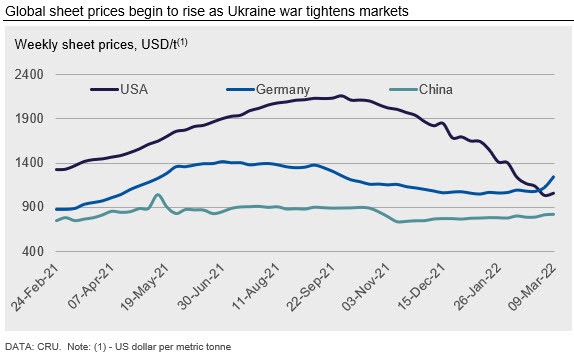International Steel Prices

Outbreak of War in Ukraine Sparks Global Sheet Price Rally
Written by Ryan McKinley
March 9, 2022
By CRU Senior Analyst Ryan McKinley, from CRU’s Steel Sheet Products Monitor, March 9
The CRUspi moved higher m/m as war in Ukraine broke steel supply chains. While prices in the USA were down m/m, this downward trajectory has now halted. Elsewhere, buyers are scrambling to secure enough steel and steelmaking raw materials before prices rise further, causing demand in most markets to rise m/m. The CRUspi flats is now back above the 300 level, and we expect this to continue to rise in coming months.

Global steel sheet supply chains have undergone significant disruptions from the outbreak of war in Ukraine, causing prices to rise in nearly every region around the world m/m. As the fighting between Russia and Ukraine drags on, steel output and the production of raw materials, including slab and pig iron, have been greatly curtailed in both countries through either physical destruction from the war or via trade inhibited by actual or potential sanctions.
Given the direct exposure of European markets to the conflict, sheet prices there have spiked in recent days and were the highest registered increase in our indices m/m. The loss of exports from both Russia and Ukraine has resulted in a major supply shock, which caused HR coil prices to rocket higher by at least €140 /t across the region (14%) over the course of just one week. However, the impact of this conflict varies by type of sheet product, with lower-priced material like slab and HR coil bearing the brunt of this supply shock relative to CR and HDG coil.
The dearth of import availability in Europe has had a knock-on effect in Asia, with Indian producers now targeting the former region for exports. Producers in India, up until the war began, had only partial success in passing on rising raw material costs to domestic end-users and other importers in Asia. Now, however, the conflict has triggered panic buying across much of Asia as buyers seek to secure material before prices rise further. This jump in immediate steel demand caused prices in Japan to rise even as domestic activity in the automotive and construction sectors remained subdued.
In China, existing heating season production limitations and steadily rising demand domestically supported prices and caused inventory levels to decrease w/w for the first time since mid-February. Moreover, with Indian producers focused elsewhere, Chinese exporters have gained an advantage as one of few low-cost suppliers to countries like Vietnam. As a result, domestic prices in China have risen, as have export offers.
Central and South America were exceptions to the global sheet price uptrend. Brazilian domestic demand was depressed by ongoing concerns surrounding the economy amid high inflation, higher interest rates, and political uncertainty during an election year. Export opportunities until late February were also limited by a strengthening Real against the U.S. dollar. As a result, Brazilian HR coil prices fell by 14% m/m. Supply was also somewhat stronger than demand in Mexico, resulting in a 3% m/m decline for the same product.
Outlook: Supply Shortages to Keep Prices Elevated
With global sheet markets tightening because of supply chain disruptions caused by the war, we see a strong bull market in prices persisting for the short term. Given the absence in import offers from the CIS and rising energy prices, European buyers will increasingly need to look further afield to secure their needs. This will help keep export, and by extension domestic, prices elevated in the Americas and Asia. Additionally, because combined Ukrainian and Russian pig iron exports comprise 65% or more of all consumption in the U.S. and Europe, we see a rapid escalation in raw material costs adding to already strong upside price pressures.
Downside price risks are minimal and growing increasingly unlikely for the short term. The largest risk is that the war comes to a sudden end and prior geopolitical relationships return to a somewhat more normal state. With this risk becoming less likely by the hour, the largest downside risk is that steel consumers overbuy in a frenzy as prices spike, only for demand to be weaker-than-expected as economies sputter under the weight of soaring inflation.

Request more information about this topic.
Learn more about CRU’s services at www.crugroup.com

Ryan McKinley
Read more from Ryan McKinleyLatest in International Steel Prices

Doubled S232 tariff holds US HR prices below EU
David Schollaert presents this week's analysis of hot-rolled coil prices, foreign vs. domestic.

Higher US CR prices inch closer to EU, Japanese tags
US cold-rolled (CR) coil prices continued to tick higher this week, while offshore markets were mixed.

Stacked S232 keeps US HR prices below EU
US hot-rolled coil prices crept up again this week but still trail imports from Europe.

Doubled S232 lifts EU, Japanese CR prices over US tags
US cold-rolled (CR) coil prices edged up again this week, and most offshore markets moved in the opposite direction. But the diverging price moves stateside vs. abroad did little to impact pricing trends. The bigger impact was from Section 232, which were doubled to 50% as of June 3. The higher tariffs have resulted in […]

CRU: Sheet demand remains weak, tariff changes again alter markets
Subdued demand has continued to weigh on steel sheet prices globally.
